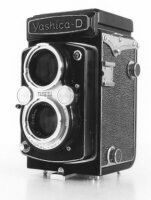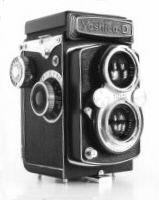Yashica D TLR
|
 My actual Medium Format work horse. It's not too big, it's not too heavy and the lens is very sharp. Only minor problem is that sometimes the frame spacing is a little off but after having exchanged the back with the back of a "A", there is a way to check if the winding was accurate. Perfect negs and perfect slides...
My actual Medium Format work horse. It's not too big, it's not too heavy and the lens is very sharp. Only minor problem is that sometimes the frame spacing is a little off but after having exchanged the back with the back of a "A", there is a way to check if the winding was accurate. Perfect negs and perfect slides...
|
 Specifications
Specifications
|
Type
| : |
Twin-Lens Reflex camera
|
|
Manufactured
| : |
late 1950s - late 1970s, mine is from 1968
|
|
Taking lens
| : |
80 mm / f=3.5 Yashinon (my camera),
the older Yashikor can also be found
|
|
Viewing lens
| : |
80 mm / f=2.8 Yashinon (my camera),
Yashikor on older versions.
|
|
Shutter
| : |
Copal MXV, Bulb, 1 - 1/500 seconds
|
|
Winding
| : |
wheel, semi manual
|
|
Cable release
| : |
Leica or Nikon Style
|
|
Filter size
| : |
Bay 1
|
|
Film Type
| : |
120
|
|
Negative Size
| : |
6 x 6 cm
|
|
Material
| : |
metal covered with leatherette
|
|
hints 'n' tips
-
When the winder mechanism is a little off try to get a broken Yashica A. They come very cheap and you can swap backs and end up with a Yashica D with a red window. When you want to use the normal winding system but double-check using the red window, you might want to experiment a little to see where you have to put the line in order to precisely stop when the red window shows the "1".
-
When your camera came with the ever-ready cover, you might have noticed that you can remove the front part and carry the camera around your neck ready-for-use.
-
Due to the Copal shutter you should be able to use flash at all shutter speeds. According to the manual however Sync speed is 1/60 or slower. Make sure you set the selector right of the lens to the "X" position when using electronic flash. The "M" setting is for flash bulbs and sets of the flash a little earlier than opening the shutter thus allowing for maximum flash-bulb light during lens-open.
-
The cable release should be of the Leica / Nikon type or alternatively you can also try to find a convertor-screw. When you have found a release cable you can attach the cable by screwing off the protection ring around the shutter release button.

-
When the view finder screen appears very dim, you can try to clean the mirror. Be very careful though. Take off the hood by unscrewing the tiny screws. Try not to touch the mirror with your fingers and try not to use any liquid cleaners as you might remove the silver from the mirror. Also try not to take out the mirror as it can easily break. When you want / need to replace the mirror, make sure you'll get glass with the exact same thickness else you'll have to adjust the viewing lens as well. Now that you have the hood off, don't forget to clean the viewing glass as well. Note that the view finder of the Yashica A appears a lot dimmer than that of the Yashica D.
-
Using a lens hood with your Yashica is a must. Not using one often results in lower contrast pictures. Best is to look for a Bay-1 Hood such as the older Rolleiflex type Bayonet. Filters and Close-Up lenses can also be used, just make sure you'll get a Bay-1 version. You can also use a Bay-1 > 49mm Adapter ring but this may obstruct the viewing lens so you might not see part of the picture you'll take.
|
 Internal links
Internal links
 The Yashica TLR Guide
The Yashica TLR Guide
 Read and Download an online copy of the The Yashica TLR Guide by Focal Press,
Read and Download an online copy of the The Yashica TLR Guide by Focal Press,
 First Edition (January 1964).
First Edition (January 1964).
 Contents: the Yashica A, B, C, D, 635, 44A, MAT, 44LM and MAT LM cameras
Contents: the Yashica A, B, C, D, 635, 44A, MAT, 44LM and MAT LM cameras
|
 My actual Medium Format work horse. It's not too big, it's not too heavy and the lens is very sharp. Only minor problem is that sometimes the frame spacing is a little off but after having exchanged the back with the back of a "A", there is a way to check if the winding was accurate. Perfect negs and perfect slides...
My actual Medium Format work horse. It's not too big, it's not too heavy and the lens is very sharp. Only minor problem is that sometimes the frame spacing is a little off but after having exchanged the back with the back of a "A", there is a way to check if the winding was accurate. Perfect negs and perfect slides...
 Specifications
Specifications
